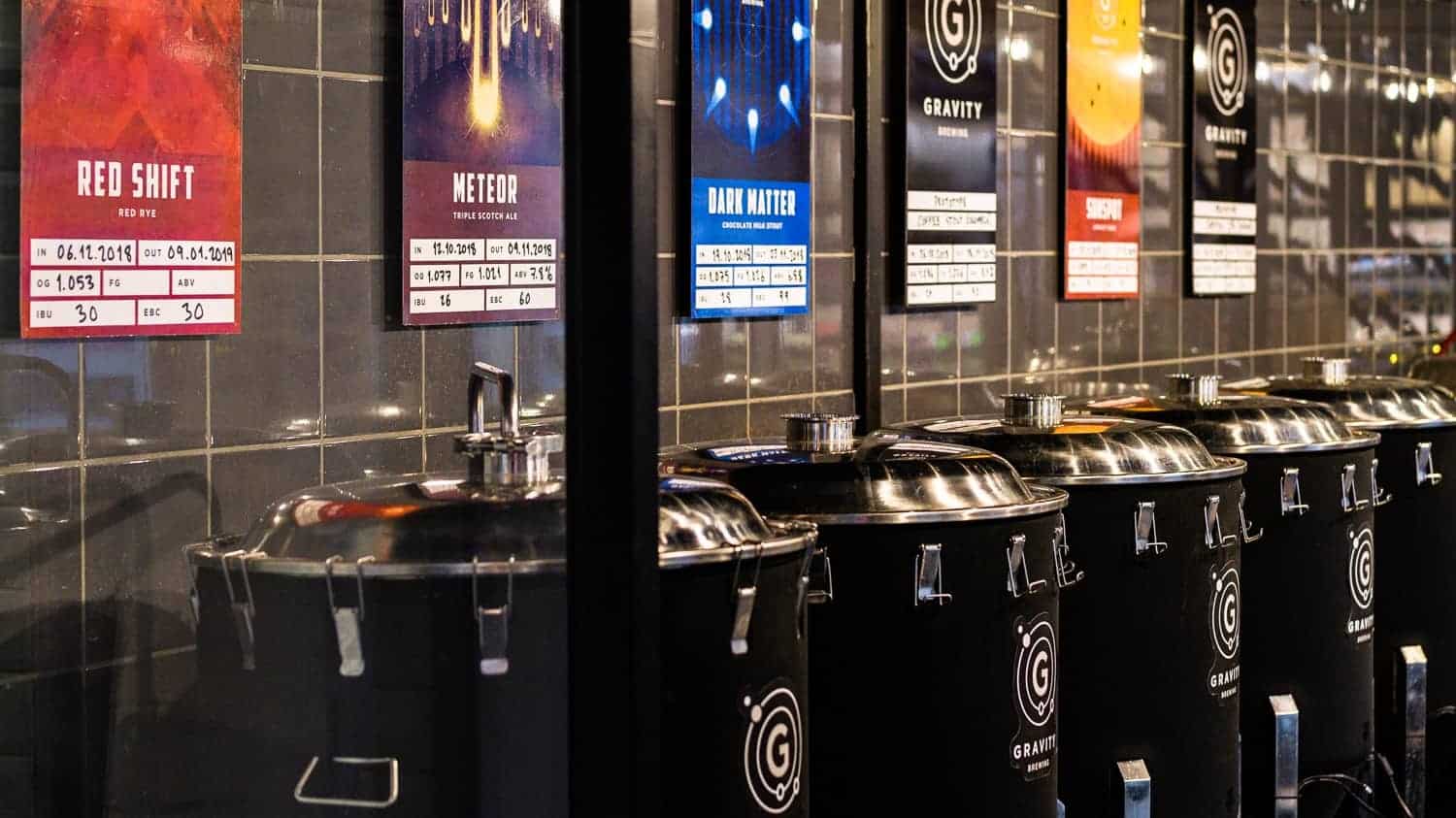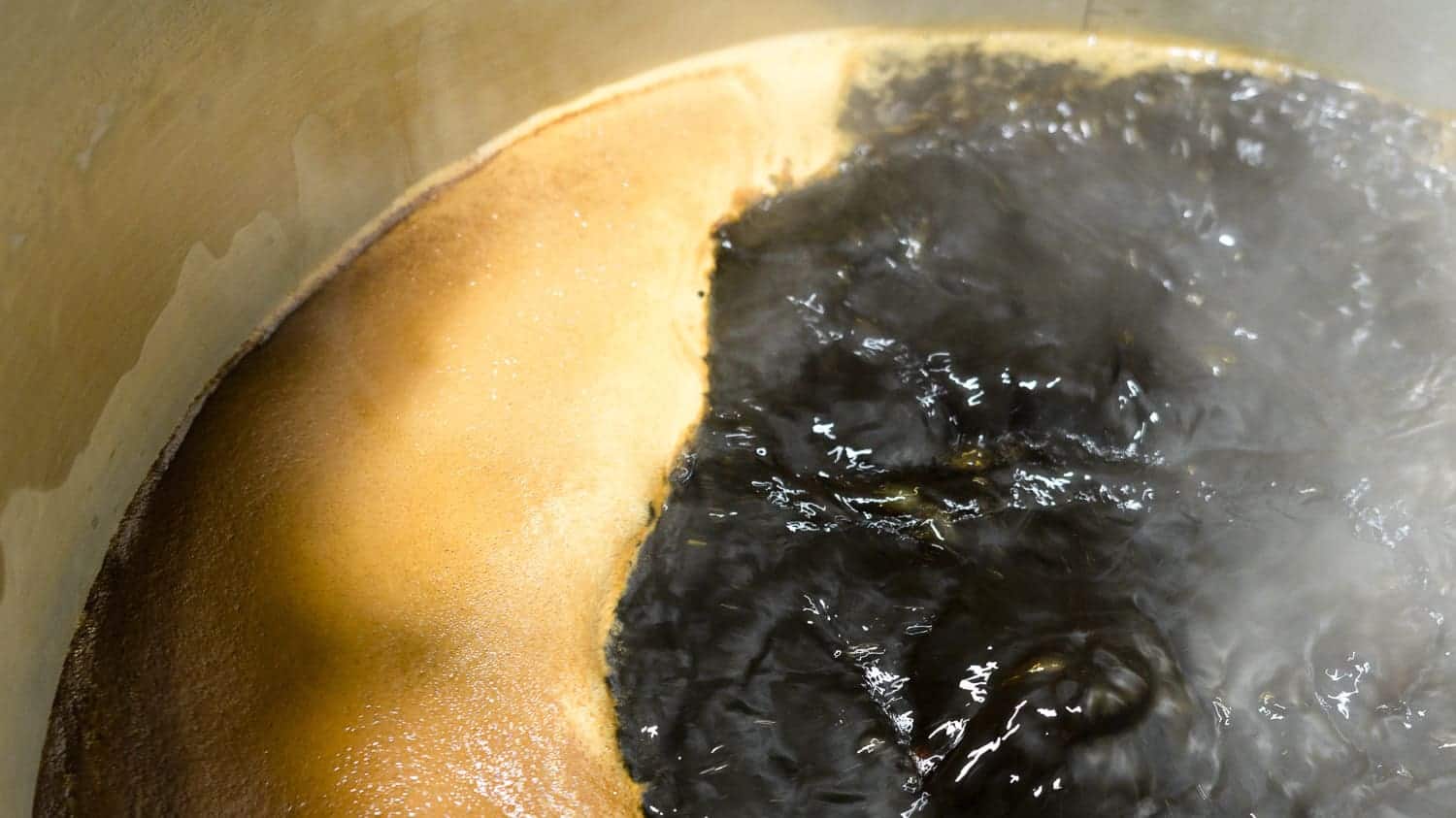This week we’re wrapping up our introduction to Gravity. Over the past 4 months, we’ve taken you through our full brew day, from the setup of our pilot brewery to the ingredients we source and our techniques for getting the most out of them. Only one part remains, in many ways the most important one: what happens after the brew?
Our cold side is the part of the brewery on permanent display, largely because it has a lot of pretty stainless and far less profanity and scalding liquids than the hot side. Things are relatively tranquil during fermentation, and the array of tanks lets us give you a preview of what we’ll be releasing next.
A lot of very important things are happening to the wort, though, in the month or more it spends in the cold side. The first and most obvious is the primary fermentation itself: after cooling the boiled wort to roughly 20C, we inoculate it with our yeast culture. The yeast strain varies depending on the beer we’re brewing, but some aspects remain constant.
Brewer’s yeast is a highly cultivated organism, bred and selected in one form or another for thousands of years of human history. The principal resulting species, Saccharomyces cerevisiae, has many variants, but they are all excellent at converting sugars into alcohols. They’re also remarkably robust, often able to withstand ethanol concentrations in excess of 10% ABV, and survive acidic environments as low as 3 pH.
Yeast does require some care, though. One of the largest factors in the move from home to commercial brewing is proper yeast health, so we always introduce plentiful yeast nutrients during the boil, oxygenate our wort to assist in the yeast’s reproductive phase, and carefully rehydrate any dry yeast before it hits the sugary wort.
Once the yeast’s viability is ensured, precise temperature control is crucial. While most commercial yeasts will continue functioning into the high 20’s, the stress of a hot fermentation can produce a host of volatile aroma compounds called esters — manageable if you’re brewing an NEIPA masked with tons of dry-hop aromatics, but not so good when your stout tastes like pear juice.
With our primary fermentation done and all our alcohol in the tank, the yeast still needs a few weeks to clean up after itself, slowly re-metabolising secondary flavour compounds which would otherwise taint the final beer. During this maturation rest, many of the harsher flavours from dark malts will mellow and blend into the background, which is why our ultra-rich imperial stouts spend a longer time in the tank than any other beer.
At this point, if it weren’t for bureaucracy, you could simply walk into the cold side and pour yourself a nice, cold, uncarbonated beer from the tank. Social convention and the NAV dictate that we have to package it first, though, so the beer goes into our ‘brite’ tank for carbonation, and then into a CO2-flushed keg for transport and sale.
At Gravity, we don’t use steel kegs. There are a few excellent reasons for this: steel kegs are expensive, require deposits, two-way transport, and chemical-intensive cleaning, and absolutely murder people’s backs.
Instead, we use a thing called a KeyKeg. You may have seen these around bars in the past few years, and they have many imitators, but fundamentally a KeyKeg is simply a lightweight, recyclable polycarbonate keg. We buy them by the pallet, and instead of retrieving empties from the bars, cleaning, flushing, and refilling them, the bar simply collapses them down to shoebox-size and puts them in their recycling.
Apart from the obvious advantages in logistics and employee health, a KeyKeg has one other advantage, which is especially useful in the infant Hungarian market. In a normal steel or plastic keg, a bar forces CO2 into the keg to push beer out of it. Because many of the tap systems in Budapest are poorly designed, however, the pressure required to maintain flow at the taps far exceeds the normal carbonation pressure of the beer.
Over time, this imbalance forces so much CO2 into solution that the beer foams constantly and begins to taste harsh from excess carbonic acid, spoiling an otherwise flawless beer after as little as a week. The problem inverts in summer, when unrefrigerated kegs all over town heat above 30C and require pressures in excess of 50psi to maintain carbonation.
Our KeyKegs solve this issue beautifully: the beer is held not in the keg itself, but in a sterile mylar bag inside the keg. When the bar forces CO2 in, the gas simply squeezes the internal bag like a balloon, forcing the beer to the tap. Because the gas never comes into contact with the beer, there’s no chance of carbonation issues, and CO2 isn’t even necessary at the bar — our mobile tap at Hollo es Roka simply replaces the lost beer volume with its internal air compressor.
If you’ve made it this far, we’d like to take this opportunity to thank you for following along with us this year. We hope you’ve enjoyed reading about our brewery’s setup and have gained some insight into what’s important to us as brewers.
Next time, we’ll be diving into more serious matters to do with the state of craft beer in Budapest. Put simply, prices are rising fast, and quality isn’t keeping up. We’ll have some thoughts on why next week in the first of our 3-part series, “The Price of Beer”.
Until then, happy drinking!


